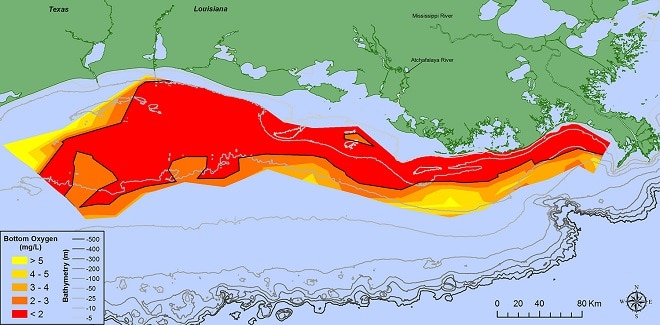STARKVILLE, Miss. — A new record has been set in the Gulf of Mexico, but it is not one to brag about because it threatens a multibillion-dollar fishing industry.
The most recent Gulf dead zone measured in the summer of 2017 was the largest ever recorded in 32 years of monitoring. It covered 8,776 square miles, which is closer to the size of New Jersey than the average zone size of 5,309 square miles. Reducing the size of the hypoxic zone is important if we want to ensure continued productivity of the Gulf fishery.
Hypoxia is a condition in which water lacks adequate oxygen to keep fish and other organisms alive. Throughout the world, there are hundreds of hypoxic zones along coasts at the outflows of rivers. These zones can occur naturally, so their mere presence isn’t necessarily concerning. What’s important is the zone size or area of the water impacted.
To understand how we can reduce the size of the Gulf dead zone, we need to first understand how hypoxia works. We then need to understand the main causes of the dead zone.
Hypoxic zones are created when large amounts of nutrients, specifically nitrogen and phosphorus, are added to the warm, sun-heated waters found in the spring and summer in the Gulf. These nutrients cause an excessive growth of algae, which die and sink to the bottom of the Gulf. Bacteria decompose the dead algae, using up so much oxygen that there isn’t enough to support other marine organisms.
Many factors may contribute to hypoxia, but the dead zone has a main driver that contributes to its large size. Nitrogen is the primary cause of algae growth in the Gulf of Mexico. This nitrogen may come from many sources, including water leaving factories, municipal wastewater treatment plants, and fertilized lawns and agricultural fields.
Everyday citizens can reduce nitrogen pollution to waterways by properly maintaining septic systems, using best practices to fertilize lawns and helping to maintain the stability of natural waterways. Although these steps are very important in reducing the dead zone’s size, the majority of the nutrients enter the Gulf of Mexico in water that runs off agricultural fields carrying excess nitrogen in fertilizers or manure.
The agricultural industry continues to research and implement management practices to reduce the nitrogen in its runoff. Although the dead zone is at its largest, the agricultural sector’s conservation investments and efforts are also at their largest. Ongoing research strives to provide the industry with the knowledge it needs to prevent nitrogen loss. With continued support from federal and state governments, along with private investments and the use of best practices, the agriculture industry will continue to battle the enlarged dead zone. Success in reducing the zone’s size depends on it.
Information provided by the Mississippi State University Extension Service.




